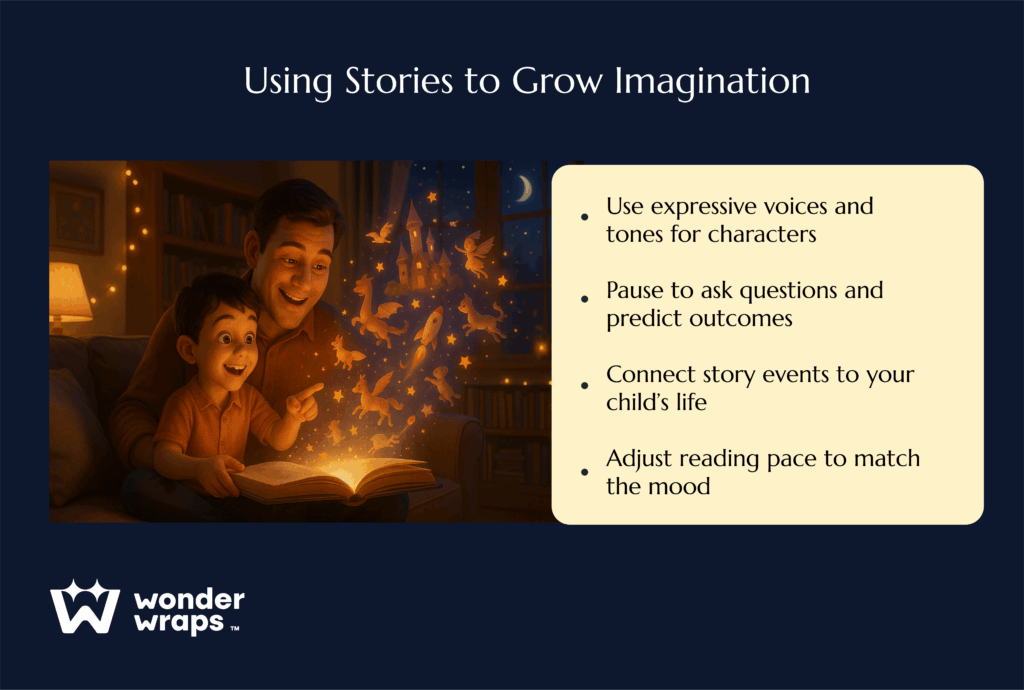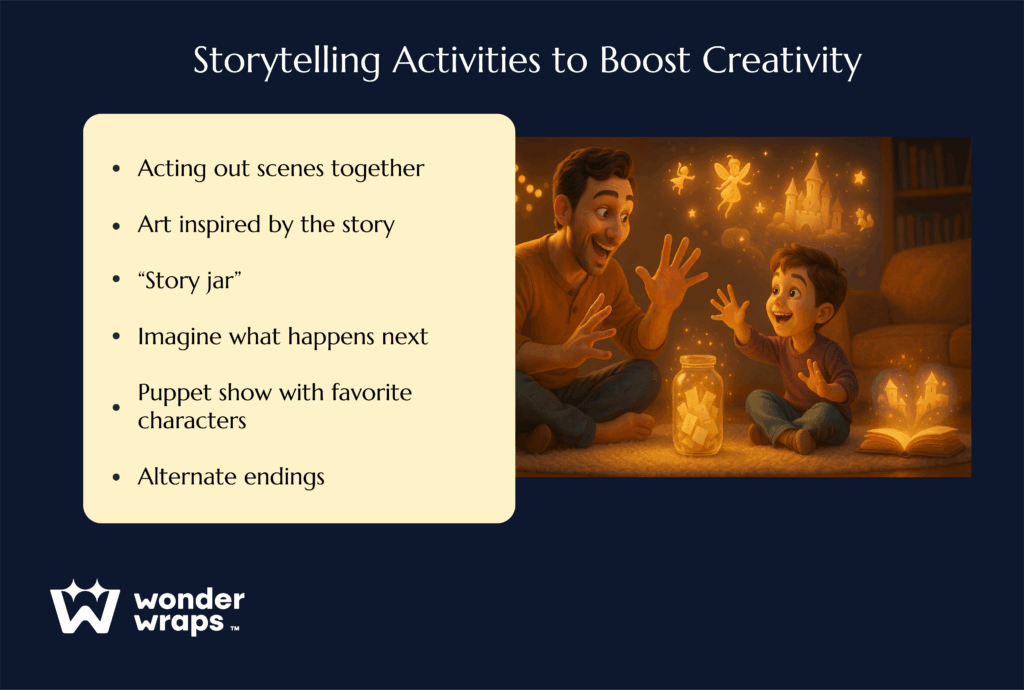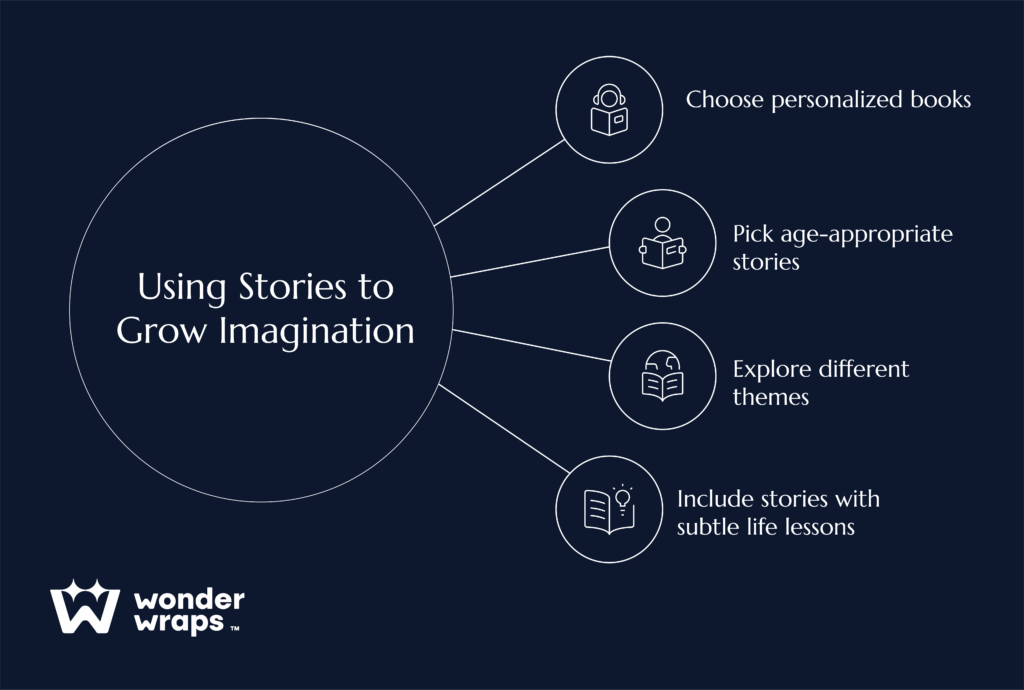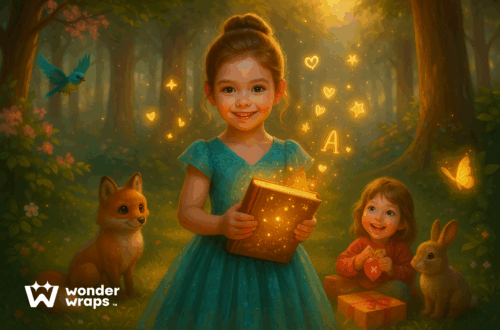Key Takeaways
- Using expressive voices, connecting story events to your child’s life, and pausing during exciting moments to ask questions are some simple techniques you can use to make every story more engaging and imagination-building.
- With personalized books, instead of watching someone else’s adventure unfold, the child becomes the hero. This level of involvement helps children see themselves as capable and confident.
- Introduce your child to stories across different genres: fantasy adventures, real-world explorations, mysteries, and tales of friendship. Each one plants different seeds for creative thinking.
There’s nothing quite like watching your child slip into their own imaginary world, where stuffed animals become explorers, kitchen chairs turn into rocket ships, and every day is a new adventure. As parents, we want to encourage that spark, and one of the most powerful ways to do so is through storytelling.
This blog is designed as your guide to growing kids’ imagination through the magic of stories.
We’ll look at why stories have such a strong impact on a child’s creativity, share practical tips you can use at home, help you choose the right books, and suggest fun activities that bring stories to life.
By the end, you’ll have simple but meaningful ways to nurture your child’s imagination, turning everyday storytime into a foundation for curiosity and lifelong creativity.
How Stories Spark Kids’ Imagination
When you read to your child, something magical happens in their mind. Each word becomes a brushstroke, painting vivid pictures they’ve never seen before. Stories open the door to new worlds, fascinating characters, and experiences far beyond their everyday life.
Through storytelling, a child can swim alongside mermaids, explore distant planets, or solve mysteries with talking animals. These experiences provide entertainment as well as a training ground for creativity.
Stories also nurture empathy by helping children see the world through different perspectives. When they follow along with characters facing challenges, making choices, and showing courage, kids begin to imagine how they might handle similar situations.
This mental exercise strengthens their ability to think creatively and approach problems with fresh ideas.
Practical Ways to Use Stories to Grow Imagination

Reading with your child isn’t only about the words on the page; it’s about how you bring those words to life. Try these simple techniques to make every story more engaging and imagination-building:
- Use expressive voices and tones to bring characters to life. When the dragon speaks in a deep, rumbly voice or the fairy whispers softly, your child can picture these characters more clearly.
- Pause during exciting moments to ask questions like “What do you think will happen next?” or “What would you do if you were the hero?” These questions encourage your child to actively participate in the story and imagine different outcomes.
- Connect story events to your child’s life by saying things like “Remember when you were brave like this character?” This helps make the narrative more meaningful and shows them they already have heroic qualities.
- Change your reading pace to match the story’s mood. Slow down during mysterious moments, speed up during chase scenes, and add dramatic pauses before big reveals.
Storytelling Activities That Inspire Creativity

Reading together is just the beginning. With a few playful activities, you can help your child carry their imagination beyond the page and into their own world of creativity:
- Act out favorite scenes together. Let your child become their favorite character and recreate the most exciting parts of the story. This physical involvement helps them connect more deeply with the narrative.
- Create art based on the stories you read. Invite your child to draw beloved characters, design new costumes for the hero, or sketch what might happen after the book ends. Art gives them a new way to express the images forming in their mind.
- Start a “story jar” filled with random words or pictures. Take turns pulling items from the jar and creating new adventures using those elements. This game shows children how any idea can become the seed of an amazing story.
- Build story extensions by asking “What happens next?” After finishing a book, spend time imagining the character’s next adventure. Your child might surprise you with their creative ideas.
- Put on a puppet show. Use simple puppets (store-bought or homemade) to retell favorite stories or invent new ones. Children love giving voices to characters, and it helps them explore storytelling in a fresh, interactive way.
- Create alternate endings. Once you finish a story, ask, “What if the character made a different choice?” or “How else could it have ended?” This activity encourages flexible thinking and shows that stories can take many paths.
How to Choose the Right Stories for Kids’ Imagination

Not all stories are created equal when it comes to sparking imagination. The right book can transform reading time into an adventure your child will treasure forever.
Choose personalized books
When your child sees their own name and photo in a story, something powerful happens. They don’t just read about the adventure; they experience it. This personal connection makes the story more vivid and believable.
Personalized children’s books place your child directly into the narrative as the main character. Instead of watching someone else’s adventure unfold, they become the hero, making brave choices and solving problems.
This level of involvement helps children see themselves as capable and confident. When they read about Girl’s Fun in the Sun or The Boy Who Could Talk to Animals, they begin to believe they’re capable of their own amazing adventures.
Wonderwraps creates beautifully illustrated personalized books where your child becomes the star of magical tales. You can customize everything from their name to their appearance, and choose from seven different languages, including English, Spanish, Italian, German, Portuguese, Dutch, and French.
Pick age-appropriate stories
The complexity of a story should grow with your child. Toddlers love simple tales with bright pictures and repetitive phrases they can predict and join in with. Preschoolers enjoy slightly more complex plots with clear heroes and problems that get solved.
As children reach school age, they’re ready for longer adventures with more detailed characters and bigger challenges. The key is finding that sweet spot where the story stretches their imagination while still matching their developmental stage.
Age-appropriate stories challenge children’s creativity at just the right level, encouraging growth without overwhelming them.
Explore different themes
Variety fuels kids’ imagination. Introduce your child to stories across different genres: fantasy adventures, real-world explorations, mysteries, and tales of friendship. Each one plants different seeds for creative thinking.
Fantasy teaches that anything is possible. Adventure builds courage in the face of challenges. Mystery sharpens problem-solving skills. Friendship stories help children understand emotions and relationships.
When children experience diverse themes, they develop a richer imagination toolkit they can use in their own creative play. Animal-themed books offer wonderful opportunities to explore different themes while learning about the natural world.
Include stories with subtle life lessons
The best imagination-building stories weave positive messages naturally into the narrative. Look for tales where characters show resilience, use creative problem-solving, practice empathy, or work together to succeed.
These stories give children frameworks for handling their own real-life situations while showing them positive ways to interact with others. When they imagine themselves in similar scenarios, they practice making good choices in a safe, story environment.
Choose children’s books that balance entertainment with gentle guidance, helping shape both imagination and character.
The Lasting Impact of Imagination Through Stories
When you nurture your child’s imagination through stories, you’re giving them a gift that lasts a lifetime. The creativity they develop in childhood becomes the foundation for adult skills like innovative problem-solving, adaptability, and the ability to see possibilities where others see obstacles.
Children with strong imaginations are often more resilient when facing challenges. Because they’ve practiced thinking creatively through story scenarios, they’re better prepared to brainstorm solutions in real-life situations.
Imagination also contributes to emotional intelligence. Through stories, children learn to understand different perspectives and consider how their actions affect others. This emotional awareness helps them build stronger relationships throughout their lives.
Perhaps most importantly, a well-developed imagination helps children maintain hope and optimism. When they can envision better outcomes and creative solutions, they’re more likely to approach life’s challenges with confidence and determination.
Kids’ learning books that combine imagination-building with educational content create a perfect foundation for lifelong learning.
The Bottom Line
Stories are more than entertainment. They’re powerful tools for building imagination and confidence. By choosing personalized tales, using interactive reading techniques, and providing diverse story experiences, you’re helping your child develop skills that will support them for years to come.
The magic happens when children see themselves as capable heroes in their own adventures. Start creating these magical moments today by exploring our books and giving your child a personalized story where they’re the star.
Frequently Asked Questions (FAQs)
Why is imagination important for kids?
Imagination helps children develop problem-solving skills, emotional intelligence, and resilience. It teaches them to think creatively and approach challenges with confidence, building foundations that benefit them throughout their lives.
When do kids develop their imagination?
Children begin developing imagination around age 2-3, and it continues growing throughout childhood. The preschool years (ages 3-6) are especially important for imagination development through stories and creative play.
How do personalized storybooks help with imagination?
Personalized books place children directly into the story as the main character, making the experience more vivid and believable. When kids see themselves as the hero, they develop stronger confidence and a deeper connection to the adventure, which strengthens their imaginative abilities.
